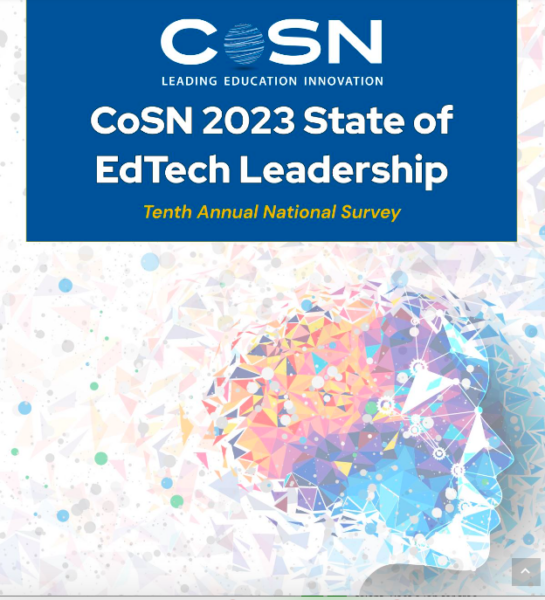The Report:
CoSN 2023 State of EdTech Leadership Survey
Highlights:
Cybersecurity
As it has since 2018, cybersecurity continues to rank as the number-one concern for EdTech Leaders. Cybersecurity is also the topic with the greatest interest for expanded professional learning.
Digital Equity
Students are less likely to receive support for off-campus broadband access than they were in 2021. During the height of remote learning, 95 percent of districts were providing off-campus broadband, compared to 74 percent of districts this year.
Modernized Infrastructure
For over ten years, the top challenge for EdTech Leaders has not changed. Budget constraints and lack of resources were ranked the number one challenge in 2013, and still rank number one in 2023.
Professional Learning
The EdTech-related professional learning topics that were of most interest to respondents—cybersecurity, driving and sustaining K-12 innovation, and data governance/privacy—directly align with district needs.
Salaries
The percentage of EdTech Leaders earning $130,000 or more has tripled over ten years, from six percent in 2013 to 18 percent today. Those earning more than $160,000 account for seven percent, compared to one percent a decade ago.
The Report:
PowerSchool 2023 Education Focus Report
Highlights:
Recognizing the current dynamics in education, the 2023 Education Focus Report focuses on four key areas: transforming the student learning experience; supporting educators and instruction; solving for the future with usable data; and partnering with parents and caretakers in student learning. Among the report’s topline findings, there is a collective sense among educators that personalized learning, actionable data, and artificial intelligence (AI) hold promise to shape the future trajectory of education.
The report reveals that a majority of educators believe technology helps personalize student learning so they can focus on individual needs and meet learning goals. However, when it comes to artificial intelligence (such as generative AI), there are varied perspectives between district leaders and school-level educators on the potential of AI to enhance teaching and learning. The report showcases current thinking about future use cases of AI, and how teachers and students can benefit.
Key findings include identifying the top priorities for the upcoming school year as providing teachers with actionable data and connecting data across systems. With evolving multi-tiered systems of supports (MTSS) and similar practices, educators often don’t have usable data to understand which tiered interventions are working.
The Report: US DOE—The State of School Diversity in the United States
The State of School Diversity report responds to a Congressional directive asking the Department to examine and publicly release information on racial and economic segregation within the United States’ K-12 educational systems using existing Department data. Report includes data that shows students of color disproportionately attend schools with majority students of color populations. According to federal data, three in five Black and Latino students and two in five American Indian/Alaska Native students attend schools where at least 75% of students are students of color, whereas about half of white students attend schools in which students of color make up less than 25% of the student population. Despite research suggesting the wide-ranging benefits associated with attending racially and socioeconomically integrated schools, isolation in schools continues.
Schools that are isolated along racial or socioeconomic lines often have less access to critical resources and funding. These conditions can perpetuate gaps in opportunity that can limit the chance for underserved students to grow and excel academically. The Biden-Harris Administration has put academic acceleration at the forefront of its agenda, with record levels of investment in K-12 schools since day one, and is committed to efforts to champion and promote diverse schools through grant funding to help fuel voluntary and legal efforts to create plans and implement strategies to increase diversity in classrooms in schools. Well-designed efforts to improve school diversity can increase access to critical resources students need to succeed, such as experienced educators and advanced coursework. Every student should have access to high-quality learning experiences, and diverse schools can help enable them to happen.
- Meet the Winners—Dr. Kellie Wilks, Chief Technology Officer, of Ector County Independent School District, TX (ECISD) - April 12, 2024
- Meet the Winners—Prince William County Public Schools (PWCS) in Manassas, Virginia wins the 2024 Community Leadership Award for Digital Equity. - April 12, 2024
- #CoSN2024 Conversation – Tom Ryan Co-Founder K-12 Strategic Technology Advisor Group (NM) - April 10, 2024

